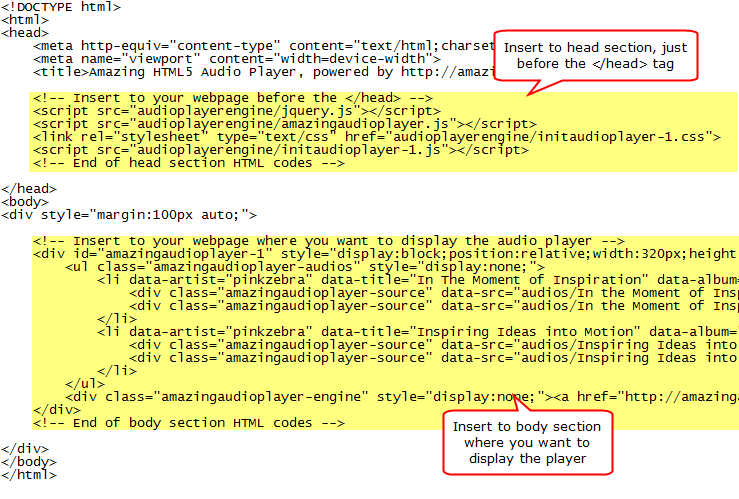

Media elements provide support for moving the current playback position to specific points in the media's content. The spec is quite unclear on the removeAttribute() scenario and setting a 'src' attribute to an empty string can cause an unwanted request (Mozilla Firefox 22).
Html5 audio file browser compatibility download#
Here's a trick that stops the download at once: var mediaElement = document.getElementById("myMediaElementID") īy removing the media element's src attribute (or setting it to an empty string-it may depend on the browser), you destroy the element's internal decoder, which stops the network download. While stopping the playback of media is as easy as calling the element's pause() method, the browser keeps downloading the media until the media element is disposed of through garbage collection. The first line fetches the first video element in the document, and the second calls the element's play() method, as defined in the nsIDOMHTMLMediaElement interface that is used to implement the media elements.Ĭontrolling an HTML5 audio player to play, pause, increase and decrease volume using some Javascript is straightforward. For example, to start (or restart) playback, you can do this: var v = document.getElementsByTagName("video") Once you've embedded media into your HTML document using the new elements, you can programmatically control them from JavaScript code. For details on media formats supported by different browsers, see Media formats supported by the audio and video elements. See Media events for a complete list of events associated with media playback.

If the type attribute is specified, it's compared against the types the browser can play, and if it's not recognized, the server doesn't even get queried instead, the next source is checked at once. If none of the specified source elements can be used, an error event is dispatched to the video element. If the type attribute isn't specified, the media's type is retrieved from the server and checked to see if the browser can handle it if it can't be rendered, the next source is checked. If the browser supports Ogg video, but not the specified codecs, the video will not load. Here, we specify that the video uses the Dirac and Speex codecs. You may also specify which codecs the media file requires this allows the browser to make even more intelligent decisions: See also the list of media formats supported by the audio and video elements in different browsers. If the browser doesn't support Ogg video, the browser uses the MPEG-4 file. This plays the Ogg video file in browsers supporting the Ogg format. Your browser does not support the video element. Multiple source files can be specified using the element in order to provide video or audio encoded in different formats for different browsers. "metadata" buffers only the metadata for the file.There’s a lot to web development, but having a “project” goal is a good way to learn, it helps keep focus on what you need to learn to get there.The preload attribute is used in the audio element for buffering large files.

Some libraries like jquery do AJAX but they’re best for people already well versed in javascript.

Once you feel comfortable with mark-up and simple javascript, you could go on to learning AJAX. You don’t need to upload files to your site or have a localhost server to test HTML pages, you can save a text file with the “.html” extension and it should open in your default browser. The site is now horribly out-of-date, so you risk having to unlearn some things later, but as long as you keep in mind that much is out-of-date it could help.
Html5 audio file browser compatibility code#
Last I knew ’s javascript tutorial section let you play with code in one panel and see the effect in another. data types, syntax, etc, and get a feel for how it works. Then you could look around and other sites to learn the basics, eg. Even this might be enough to let you start getting your hands dirty right away. You don’t need more than getting familiar with how it looks to start. The mark-up you’ll find is often not best practice but it can help a lot. And there’s always right-click viewsource to see how pages have been written. You could start by looking at and other sites. I think the best place to start is to get familiar with HTML. The way things change so fast it’s impossible to keep up anyway, but of course the more you know the better. The good news is you don’t need to be an expert in everything. It’s been a while since I was just starting, so I may be missing things I now take for granted, but I’ll try.


 0 kommentar(er)
0 kommentar(er)
